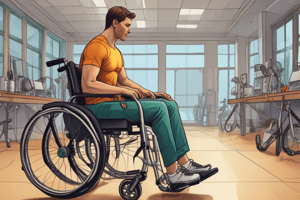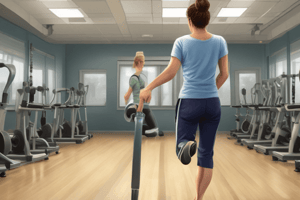Podcast
Questions and Answers
What is the first step in the rehabilitation process?
What is the first step in the rehabilitation process?
- Protect the area from further injury. (correct)
- Re-establish range of motion (ROM), flexibility, and tissue mobility.
- Re-establish proprioception, coordination, and agility.
- Re-establish neuromuscular control, muscular strength, endurance, and power.
What is the primary cause of ankle sprains?
What is the primary cause of ankle sprains?
- Poor ankle flexibility.
- Overexertion of the ankle muscles.
- Rolling, twisting, or turning the ankle beyond its normal range of motion. (correct)
- Wearing inappropriate footwear.
What is the criteria for returning to activity after an ankle sprain?
What is the criteria for returning to activity after an ankle sprain?
- The patient has regained full range of motion and strength.
- The patient meets all six criteria, including being psychologically ready. (correct)
- The patient is pain-free and has minimal swelling.
- The patient has rested for a minimum of two weeks.
What is the most common type of ankle sprain?
What is the most common type of ankle sprain?
What is the grade of an ankle sprain that results in a stretching of the ligamentous fibers?
What is the grade of an ankle sprain that results in a stretching of the ligamentous fibers?
What is the function of the deltoid ligament?
What is the function of the deltoid ligament?
What is a common symptom of an ankle sprain?
What is a common symptom of an ankle sprain?
What is the last step in the rehabilitation process?
What is the last step in the rehabilitation process?
What is the primary method of assessing the severity of an ankle injury?
What is the primary method of assessing the severity of an ankle injury?
Which test is used to assess the integrity of the anterior talofibular ligament?
Which test is used to assess the integrity of the anterior talofibular ligament?
What is the primary goal of proprioceptive training in ankle rehabilitation?
What is the primary goal of proprioceptive training in ankle rehabilitation?
Which of the following is NOT a component of the PRICE method?
Which of the following is NOT a component of the PRICE method?
What is the primary purpose of perturbation training in ankle rehabilitation?
What is the primary purpose of perturbation training in ankle rehabilitation?
Which of the following exercises is NOT recommended in the acute phase of ankle rehabilitation?
Which of the following exercises is NOT recommended in the acute phase of ankle rehabilitation?
What is the purpose of taping, bracing, and orthotics in ankle rehabilitation?
What is the purpose of taping, bracing, and orthotics in ankle rehabilitation?
What is the primary goal of strengthening exercises in ankle rehabilitation?
What is the primary goal of strengthening exercises in ankle rehabilitation?
What is the time frame for returning to activity for Grade I injuries?
What is the time frame for returning to activity for Grade I injuries?
What is the primary function of the plantar fascia?
What is the primary function of the plantar fascia?
What is a common cause of heel pain in the morning?
What is a common cause of heel pain in the morning?
What is the primary method of diagnosing plantar fasciitis?
What is the primary method of diagnosing plantar fasciitis?
What is a common treatment for plantar fasciitis?
What is a common treatment for plantar fasciitis?
What is the main function of the Achilles tendon?
What is the main function of the Achilles tendon?
What is a common symptom of Achilles tendinitis?
What is a common symptom of Achilles tendinitis?
What is the purpose of evaluating pain levels in Achilles tendinitis?
What is the purpose of evaluating pain levels in Achilles tendinitis?
What is the duration of the treatment protocol for Achilles Tendinopathy?
What is the duration of the treatment protocol for Achilles Tendinopathy?
What is the primary cause of Tarsal Tunnel Syndrome?
What is the primary cause of Tarsal Tunnel Syndrome?
What is the most common symptom of Tarsal Tunnel Syndrome?
What is the most common symptom of Tarsal Tunnel Syndrome?
What is the primary purpose of sensory testing in Tarsal Tunnel Syndrome diagnosis?
What is the primary purpose of sensory testing in Tarsal Tunnel Syndrome diagnosis?
What is the location of tenderness to palpation in Tarsal Tunnel Syndrome?
What is the location of tenderness to palpation in Tarsal Tunnel Syndrome?
What is the significance of muscle atrophy of the abductor hallucis muscle in Tarsal Tunnel Syndrome?
What is the significance of muscle atrophy of the abductor hallucis muscle in Tarsal Tunnel Syndrome?
What is the purpose of gait analysis in Tarsal Tunnel Syndrome diagnosis?
What is the purpose of gait analysis in Tarsal Tunnel Syndrome diagnosis?
What is the goal of assessment in Tarsal Tunnel Syndrome?
What is the goal of assessment in Tarsal Tunnel Syndrome?
Flashcards are hidden until you start studying
Study Notes
Rehabilitation Steps
- Protect the area from further injury
- Decrease pain, swelling, and spasm
- Re-establish range of motion (ROM), flexibility, and tissue mobility
- Re-establish neuromuscular control, muscular strength, endurance, and power
- Re-establish proprioception, coordination, and agility
- Re-establish functional skills
Return to Activity Criteria
- Patient is pain-free
- Ankle is not swollen
- Ankle has full, functional ROM
- Ankle has full, functional muscle strength, endurance, and power
- Patient has adequate proprioception, balance, agility, and coordination
- Patient is psychologically ready to return to activity
Ankle Sprain
- Occurs when ligaments in the ankle get stretched or torn
- Commonly occurs when the ankle rolls, twists, or turns beyond its normal range of motion
- Ankle ligaments: Anterior Talofibular Ligament, Calcaneofibular Ligament, Posterior Talofibular Ligament, Deltoid Ligament
- Sprain Grades:
- Grade I: Stretching of ligamentous fibers (minor)
- Grade II: Partial tearing of ligamentous fibers (moderate)
- Grade III: Substantial tearing of ligamentous fibers (severe)
- Types of sprains:
- Pronation or eversion type (MED - deltoid ligament)
- Supination and inversion type (LAT - most common, involves anterior talofibular ligament)
- Symptoms: Pain, swelling, bruising, instability, difficulty bearing weight
- Diagnosis: Physical examination, X-rays, MRI (if severe)
- Physical Examination:
- Inspection (swelling, deformities, redness)
- ROM (dorsiflexion, plantar flexion, inversion, eversion)
- Palpation (malleolus, achilles tendon, base of 5th metatarsal, proximal fibula, midfoot)
- Assess strength, flexibility, and neurovascular status
- Treatment: PRICE method, bracing, physical therapy, proprioceptive training, strengthening exercises
- Return to activity:
- Grade I: 1-2 weeks
- Grade II: 4-8 weeks
- Grade III: 12-16 weeks
Plantar Fasciitis
- Inflammation of the plantar fascia, a thick band of tissue connecting the heel bone to the toes
- Contributes to the support of the arch of the foot and dynamic function during gait
- Causes: Overuse, improper footwear, biomechanical issues
- Symptoms: Heel pain, especially in the morning, tenderness over the heel
- Diagnosis: Clinical examination, imaging (X-ray, MRI)
- Assessment: Identifying risk factors (foot arch, running habits, footwear)
- Treatment: Conservative - stretching, orthotic devices, night splints, manual therapy, trigger point therapy, orthosis, and taping
- Modalities: Electrotherapy, ultrasound, and soft orthotics
- Stretching: Plantar fascia specific stretch and calf muscle stretch
- Exercises: Tennis ball roll out, tennis ball heel pump, tennis ball toe curl, calf raises, toe raises
Achilles Tendinitis
- Inflammation or irritation of the Achilles tendon
- Causes: Overuse, repetitive stress, or sudden increases in activity level
- Symptoms: Morning stiffness, Achilles tendon tenderness, variable pain
- Diagnosis: Clinical assessment, imaging studies
- Assessment: Evaluating pain levels, functional limitations
- Treatment: PRICE protocol, eccentric exercise program, physiotherapy (manual techniques, specific exercises, stretches), gradual running progression, plyometrics, and agility drills
- Takes 3-6 months
- Exercises: Standing soleus stretch, towel stretch, heel raise, step up, standing calf stretch, soleus stretching, gastrocnemius stretching, toe raise with straight leg and with bent leg, heel drop from stair stretch
Tarsal Tunnel Syndrome
- Rare compressive neuropathy of the tibial nerve or one of its branches
- Causes: Repetitive stress activities, traumas, heel varus or valgus, excessive weight
- Symptoms:
- Burning (paresthesia) or tingling sensation in the sole of the foot
- Pain worsened by activity and gets better with rest
- Dysesthesia (an abnormal and unpleasant sensation) arises during the night and can disturb sleep
- Weakness of muscles
- Diagnosis: Clinical evaluation, nerve conduction studies, imaging
- Observation: Muscle atrophy of the abductor hallucis muscle may be seen, check for arch stability, position of the talus and calcaneus
- Gait Analysis: Assess for abnormalities, excessive pronation/supination, toe out, excessive inversion/eversion, antalgic gait, etc.
- Sensory Testing: Test light touch, 2-point discrimination in the lower extremity (deficits will be in the distribution of the posterior tibial nerve)
- Palpation: Tender to palpation in between the medial malleolus and Achilles tendon (painful in 60-100% of those affected)
- Assessment: Identifying sensory deficits, muscle weakness, and gait abnormalities
Studying That Suits You
Use AI to generate personalized quizzes and flashcards to suit your learning preferences.




